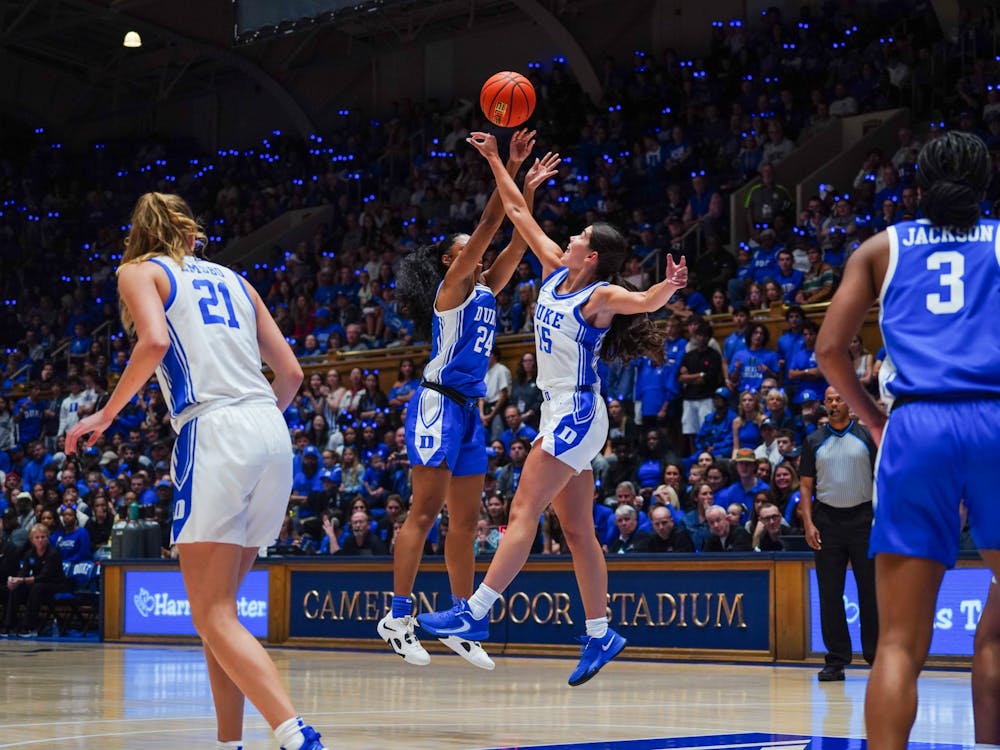Editor's note: This article is a counter to Ryan's argument that Duke will struggle with its small roster. Read that piece, here.
It’s natural for Duke’s expectations to plummet once its limited roster size is considered. How could any team benefit from having so few players?
The Blue Devils are working with a roster of 11 players for the 2023-24 season, including an injured Vanessa de Jesus who will miss the season due to a knee injury. Duke’s abnormally narrow lineup may seem to only harm the potential of the team, but there is a silver lining to the situation.
First off, each player will have a greater share of development time. At this year’s Countdown to Craziness, there was not a single sub in the women’s basketball 5-on-5 scrimmage. All 10 healthy players were on the court. The same goes for every scrimmage in practice. Duke’s limited roster ensures that every player is developing because practice cannot go on with players not playing.
The smaller roster size will also help the players gain consistency in their lineups and rotations for games. While teams with larger roster sizes may take several games to solidify their rotations and several more to develop regularity, the Blue Devils are forced to learn consistency from the get-go. Head coach Kara Lawson simply has very little opportunity to experiment with unique permutations of the Blue Devil rotation, forcing her to get uniquely comfortable, instead, with one or two permutations.
Looking back at games from last season — when the Duke team had 16 players — it may seem that Lawson utilized every piece of her roster to its full ability. Nine different players on Duke’s 2022-23 roster were in the starting lineup at one point during the season. In reality, however, the lower echelon of Lawson’s roster barely got a taste of the hardwood. Five players played less than 30 minutes total throughout the season. Last year’s roster could have very easily been significantly smaller with little to no impact on the outcome of the season. In fact, there wasn’t a single conference game where more than 10 players played more than five minutes in the game. Lawson seldom created a rotation with more women than the team currently has. The only thing that a wider range of choices did was allow her to disrupt a consistent unit.
Consider last season’s national championship game between LSU and Iowa. As Ryan mentioned, the national champion Tigers played only eight players in the championship game and still won handily. LSU’s championship run shows that a close-knit team with good chemistry is more important than having a deep lineup with substitute players who get no playing time.
But what if Lawson’s squad just doesn’t have the chemistry to properly compete? Team chemistry doesn’t happen overnight. It takes practice, and familiarity needs to be developed amongst teammates. With only 10 uninjured players on the roster, the team will be forced to develop that chemistry. Last season, if two players had conflicts or differences on the court, Lawson could opt not to put them in a game at the same time, to keep them separate. This season, the Blue Devils will be forced to squash any volatility and ensure that sisterhood takes a front seat in the development process.
Across the board, the Blue Devils tend to emphasize the culture they develop as teammates, and Duke’s limited roster will only magnify this effect. With just 11 players on the roster, the team can more easily develop into a family on and off the court, contributing to team chemistry. While the fact that every healthy player will likely be a part of Lawson’s rotation may seem risky, it only adds to the cohesiveness of the team. No player will fear that her position could be taken by a teammate, making disagreements less likely to arise. Every player will play a crucial role in the success of the team, increasing the confidence of the entire roster.
Quality over quantity, right? Duke has added four freshman recruits to The Sisterhood for the upcoming season, along with graduate forward Camilla Emsbo. The Yale transfer was unanimously voted First Team All-Ivy League her junior season and only missed her senior season due to injury. She was still captain, though. Next to the many talented young players new to the team, Emsbo will bring the experience and maturity required to develop Duke’s decagon of chemistry.
Time will tell if Lawson’s 10-woman system will be able to prove effective over the course of the season, but for now, there’s still hope that Duke can muster a competent team with its current roster. Don’t be so quick to bet against the Blue Devils.
Get The Chronicle straight to your inbox
Signup for our weekly newsletter. Cancel at any time.

